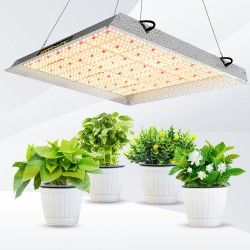Why Plants need Full spectrum Grow lights
Like plants, not all grow lights are created the same.
We have touched on the evolution of grow lights in a previous example, which has a brief explanation of how technology has improved to get to where we are now. The Quantum Board LED.
Quantum Board LED’s provide more light with a Lower heat output which does away with the need for large heat sinks and fans.
There is also a tonne of research which has gone into creating a light fitting which closely resembles the Suns’ rays.
During the Day, Sunlight is most intense. During this period, your plant will require more blue light and less red light.
This is so that the plant can focus on growing during extended sunlight hours in Summer.
At Sunset and Sunrise, your plant is exposed to more Red light than blue light.
Just like our bodies, plants are programmed to respond to the amount of red or blue light, and how many hours a plant is exposed to different light spectrum’s affects whether the plant is in a Vegetative state or Flowering.
In the old days, this meant swapping grow lights between vegetative state and flowering/fruiting.
You would need a set of blue bulbs for growing (vegetative), and a set of red bulbs for flowering to simulate the sun sitting lower in the sky in Autumn and producing more red light.
To effectively grow, a plant needs Red light, Blue light, Warm White, and Cool White, and also Infra-red (Invisible to human eye). Check out what light spectrum is best for your plants at different growth stages here.
Since a full spectrum grow light closely resembles light from the Sun’s rays, you will be able to grow a plant indoors as if it was outside in full sunlight. You can also grow your plant under full spectrum grow lights for up to 24 hours a day – you can give your plant more light inside than if it was planted outdoors.
We are also noticing that worldwide, more families are moving in to Studios and Apartments. It is common for many people to have no access to an outdoor garden. With Global warming on our doorstep, We are noticing changing weather conditions and increased pathogen and insect problems. Outdoors, Seasons can be unreliable, and crops do not always return a high yield. According to the 2016 IKEA Life at Home Report, 60 percent of people worldwide are already growing vegetables, flowers, or herbs indoors.
With parents becoming increasingly aware that children need to be involved with activities relating to healthy food and ‘Clean growing’ we are noticing an increase in Millenials and Boomers wanting access to home grown produce.
There is no wonder that indoor gardening is called “The Farming of the Future”. We’re going, you’re invited.


